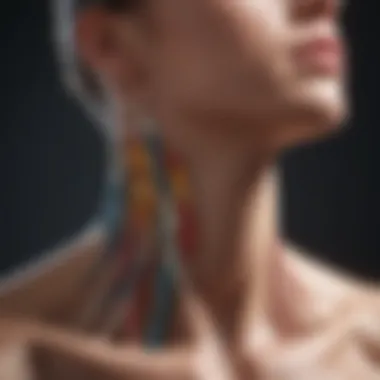Effective Strategies for Pinched Nerve Relief


Intro
A pinched nerve in the neck can lead to a range of discomforting symptoms. This condition arises when there is pressure on the nerve, which can occur due to various factors such as herniated discs, poor posture, or repetitive strain. The consequences of this issue can affect daily life, work, and mental health. Understanding how to correct a pinched nerve is essential for those affected.
Identifying the symptoms can be the first step towards effective management. Common signs include pain, numbness, tingling, or weakness in the arms or hands. Without timely intervention, these symptoms can escalate, potentially leading to chronic pain or mobility issues. Therefore, it’s crucial to recognize the importance of addressing this condition promptly.
This article will explore strategies for managing a pinched nerve in the neck. It will cover immediate care methods, professional treatments, and lifestyle changes that can promote wellness and prevention. By engaging with this information, readers can make informed choices about their health.
Understanding Pinched Nerves in the Neck
Understanding the concept of a pinched nerve is crucial for anyone experiencing discomfort in the neck area. This section addresses key factors about pinched nerves including definitions, causes, and anatomical context. By exploring these elements, individuals gain insight that can lead to effective management and potential resolution of their symptoms.
Definition of a Pinched Nerve
A pinched nerve occurs when surrounding tissue applies excessive pressure to a nerve. This can lead to both pain and dysfunction. It is important to grasp that the nerve itself may not be damaged. The symptoms arise from compression on the nerve, which disrupts its normal function. Symptoms often manifest as numbness, tingling, or radiating discomfort in associated areas. In the case of neck nerves, discomfort may also affect the arms and shoulders, leading to significant limitations in daily activities.
Causes of Pinched Nerves
Various factors contribute to the occurrence of pinched nerves in the neck. Common causes include:
- Herniated Discs: Discs act as cushions between vertebrae and can bulge, leading to pressure on nearby nerves.
- Bone Spurs: Age-related joint changes may lead to formations that can compress nerves.
- Inflammation: Conditions such as arthritis can lead to swelling, contributing to nerve compression.
- Injuries: Trauma or incorrect posture during activities can lead to nerve damage.
Understanding these causes is vital as it informs proper treatment strategies. The root of the issue must be identified to alleviate symptoms effectively.
Anatomy of the Neck
Anatomically, the neck consists of vertebrae, muscles, and nerves that work harmoniously for functional movement. There are seven cervical vertebrae stacked atop one another, and each vertebra has a corresponding nerve branch that exits the spinal column. The cervical plexus is a network of nerves responsible for feeling and movement in the neck and upper shoulders.
A brief overview of the anatomy related to pinched nerves is as follows:
- Cervical Vertebrae: Support the head and protect the spinal cord.
- Nerves: Transmit signals between the brain and body.
- Muscles: Support, stabilize, and allow for head movement.
Recognizing the anatomy helps in understanding how particular movements or conditions can lead to nerve compression. Awareness of these components allows for a more informed discussion on treatment and recovery strategies.
Recognizing Symptoms of a Pinched Nerve
Recognizing the symptoms of a pinched nerve in the neck is crucial for effective management and treatment. Early identification allows individuals to respond appropriately, potentially preventing long-term damage or chronic discomfort. Symptoms can vary widely in their presentation; some may be subtle, while others can be strikingly apparent. Understanding these signs is important for everyone, particularly health professionals who may encounter patients experiencing these issues. By being aware of the symptoms, one can better inform diagnosis and treatment protocols and ultimately improve outcomes for those affected.
Common Symptoms
Common symptoms of a pinched nerve in the neck may include:
- Radiating Pain: Individuals often report pain that radiates from the neck into the shoulders, arms, or even the hands. This discomfort can range from mild to severe, often described as sharp or burning.
- Numbness or Tingling: Many people experience sensations of numbness, tingling, or a "pins and needles" feeling. This often occurs in the areas supplied by the affected nerve.
- Weakness: Muscular weakness can manifest in the shoulder, arm, or grip strength. This may be especially noticeable while performing daily tasks or physical activities.
- Discomfort or Tightness: Some people may notice stiffness or discomfort in the neck region itself, which can further limit range of motion and exacerbate the overall issue.
Recognizing these symptoms is the first step towards addressing the underlying problem effectively.
Identifying Severe Symptoms
In some cases, the symptoms of a pinched nerve can escalate to severe conditions that require immediate attention. Key indicators of more serious issues include:
- Persistent or Worsening Pain: If pain continues to intensify despite rest and home care remedies, this may indicate complications.
- Loss of Control: In cases where there is a sudden loss of control over bowel or bladder function, immediate medical intervention is necessary.
- Significant Weakness: If there is substantial weakness in the arms or hands that affects the ability to perform basic tasks, it could be a sign of a more severe problem.
- Changes in Sensation: Severe numbness or tingling that spreads and does not resolve can be a cause for concern.
Identifying these severe symptoms quickly can be life-changing, highlighting the importance of prompt action.
When to Seek Medical Attention
Determining when to seek medical attention is an important part of managing symptoms related to a pinched nerve. It is advisable to consult a healthcare professional under the following conditions:
- If symptoms persist despite self-care measures for more than a few days.
- In cases where new symptoms arise, such as significant weakness, loss of coordination, or changes in bladder or bowel function.
- If the pain is accompanied by fever or unexplained weight loss, as these could indicate an underlying condition.
- Any significant change in neurological symptoms should prompt immediate evaluation.
Always prioritize your health. If in doubt about the severity or implications of symptoms, it is better to err on the side of caution and consult a qualified healthcare provider.
Understanding these aspects of recognizing symptoms empowers individuals and health professionals alike, facilitating timely intervention and promoting healing.


Initial Home Care Strategies
Addressing a pinched nerve in the neck effectively begins with initial home care strategies. These strategies are essential because they can provide early relief and prevent further complications. They equip individuals with practical steps to manage discomfort and promote healing. Implementing these strategies creates a foundation for recovery that may reduce the need for invasive treatments later.
Rest and Recovery
Rest is a fundamental aspect when dealing with a pinched nerve. The body needs time to heal, and rest reduces additional strain on the affected area. It is crucial to listen to your body and avoid activities that exacerbate the pain, such as heavy lifting or repetitive motions. Instead, prioritize gentle movements and positioning that alleviates discomfort.
Consider using supportive pillows while sleeping, as this can help maintain proper neck alignment. Short, frequent breaks during activities can also help prevent irritation. Recovery is not just about inactivity; it is about finding a balance that supports healing while maintaining mobility. The conscious choice to rest, even if briefly, becomes important in the healing process.
Applying Ice or Heat
Applying ice or heat can offer swift relief from pain associated with a pinched nerve. Each method serves distinct purposes. Ice therapy is effective in the acute stages, especially during the first 24 to 48 hours of discomfort. Cold compresses help reduce inflammation and numb the area, leading to temporary pain relief. It is important to limit the use of ice to about 15-20 minutes at a time, ensuring the skin is protected with a cloth to avoid frostbite.
Conversely, heat application is beneficial after the initial swelling has subsided. Heat promotes blood flow to the area, easing muscle tension and enhancing flexibility. Thermo patches, warm towels, or heating pads can be used, with similar timing guidelines as ice application to avoid skin damage. Understanding when to use each method helps maximize comfort and improve recovery outcomes.
Over-the-Counter Pain Relief
For many individuals, over-the-counter pain relief options provide additional support during recovery. Common medications such as ibuprofen or acetaminophen can effectively manage pain and reduce inflammation. It is important to follow the indicated dosages and directions found on the packaging to ensure safe usage.
While these medications can alleviate symptoms, they do not treat the underlying cause of the problem. Therefore, it is essential to combine these medications with other recovery strategies mentioned earlier. Additionally, consulting with a healthcare professional regarding prolonged use or when symptoms worsen can guide the use of pain relief methods safely.
Always consider potential allergies or interactions with other medications before using any over-the-counter option.
In summary, implementing initial home care strategies plays a pivotal role in managing a pinched nerve in the neck. Through effective rest, application of ice or heat, and proper pain relief, individuals can take proactive steps towards recovery and improve their quality of life.
Professional Treatment Options
In addressing a pinched nerve in the neck, professional treatment options play a crucial role. They are designed to complement initial home care strategies and provide an effective last line of defense against chronic pain and discomfort. These treatments are tailored to the individual’s symptoms and underlying causes. By involving healthcare professionals, one can access advanced techniques and better management protocols that promote healing and recovery.
Physical Therapy
Physical therapy is often the primary recommendation for individuals suffering from a pinched nerve. The therapist designs a program specifically for the patient, focusing on relieving pressure on the affected nerve. This is achieved through targeted exercises that strengthen muscles and improve flexibility.
The benefits of physical therapy include improved mobility, reduction of pain, and the prevention of further injury. A therapist may also guide patients on posture correction and ergonomics, which are critical in reducing strain on the neck. The sessions usually involve:
- Strengthening exercises to support the neck and shoulder muscles.
- Stretching routines that enhance range of motion.
- Manual therapy techniques that manipulate neck structures to relieve tension and improve alignment.
Commitment to a regular physical therapy schedule can greatly improve outcomes over time.
Chiropractic Care
Chiropractic care focuses on spinal alignment and adjustment, which can have a direct impact on nerve function. Chiropractors employ various manipulation techniques to alleviate pressure from the pinched nerve. This not only eases pain but also aids the body in returning to its natural state of balance and function.
Patients often report immediate relief following a chiropractic adjustment. Regular sessions can lead to:
- Reduced inflammation in the affected area.
- Improved range of motion in the neck and surrounding regions.
- Enhanced overall well-being due to the interconnected nature of the body's systems.
Chiropractic care can be an effective complementary strategy when combined with physical therapy and other interventions.
Injections and Medications
In cases where conservative measures do not suffice, injections and medications may be considered. Corticosteroid injections are common and can provide temporary relief by reducing inflammation around the nerve. Additionally, nerve blocks can be administered to interrupt pain signals sent to the brain.
Medications typically include anti-inflammatory drugs, muscle relaxants, and pain relievers, prescribed based on individual need. These options can:
- Offer quick relief from acute pain.
- Help in maintaining your daily activities while pursuing longer-term treatment solutions.
However, reliance on medications should be monitored closely to avoid potential side effects or dependency.
Surgical Procedures
When all conservative therapies fail to provide relief, surgery may be necessary. Surgical intervention often involves decompression techniques that alleviate pressure on the nerve root. Procedures may include:


- Discectomy, where part of a herniated disc is removed.
- Foraminotomy, which widens the opening where the nerve exits the spine.
- Fusion surgery, which stabilizes the cervical spine if multiple vertebrae have been affected.
Surgery is typically viewed as a last resort and is recommended only when other treatments have been ineffective. Potential risks and benefits should be thoroughly discussed with a healthcare provider, as recovery can be gradual and may require subsequent rehabilitation.
Always consult with a healthcare professional to determine the most appropriate treatment for a pinched nerve. Individual circumstances and health conditions can greatly influence the recommended approach.
In summary, professional treatment options encompass a variety of methods that target different aspects of managing a pinched nerve. From physical therapy to surgical intervention, a tailored approach can significantly contribute to managing pain and facilitating recovery, leading to improved quality of life.
Rehabilitation and Recovery
Rehabilitation and recovery play a crucial role in addressing a pinched nerve in the neck. After a diagnosis and initial treatment, the path to full recovery often involves structured rehabilitation. This process is essential for restoring function and preventing future issues. Without proper rehabilitation, symptoms might persist, and the risk of re-injury could increase significantly.
In this phase, physical therapy and guided exercises contribute greatly. They strengthen muscles, improve flexibility, and enhance overall posture. A well-structured rehabilitation plan encourages gradual improvement, allowing individuals to regain strength while minimizing pain. Following a tailored exercise routine can also aid in balancing muscle function in the neck, which is critical for a sustainable recovery.
Importance of Follow-Up Treatment
Follow-up treatment is vital after initial care for a pinched nerve. Regular check-ups allow healthcare providers to monitor progress and make necessary adjustments to the rehabilitation plan. This entails evaluating any remaining symptoms and ensuring that exercises are performed correctly to avoid setbacks.
Benefits of follow-up treatment include:
- Personalized adjustments: Treatment can be adapted based on the individual's response.
- Preventive education: Patients can learn how to avoid certain movements that may aggravate their condition.
- Ongoing support: Regular appointments provide encouragement and accountability, fostering a better compliance with the rehabilitation program.
It is essential not to underestimate the role of follow-up in the recovery process. Effective management of symptoms often hinges on these continued interactions with health professionals.
Gradual Return to Activities
A gradual return to activities is another key aspect of rehabilitation after dealing with a pinched nerve. Rushing into normal routines can jeopardize recovery and exacerbate symptoms. Instead, a step-by-step approach is recommended, which allows the body to adapt to increased activity levels.
Here are some considerations for a gradual return:
- Listen to your body: Awareness of pain levels and discomfort is crucial. Any increase in symptoms should be taken seriously.
- Modify tasks: Adjusting daily activities can help ease the transition. For instance, switching from heavy lifting to lighter tasks can help maintain functionality while minimizing risk.
- Incorporate rest: Balancing activity with adequate rest periods prevents overexertion, promoting healing.
"Progress might be slow, but each step matters in the long-term recovery journey."
Following these guidelines can help ensure that the return to regular activities is smooth and safe, thereby enhancing overall recovery from the effects of a pinched nerve.
Preventive Measures
Preventive measures play a crucial role in managing the risks associated with a pinched nerve in the neck. By incorporating certain practices into daily life, individuals can significantly lower the likelihood of encountering nerve compression. Prevention not only safeguards against acute incidents but also promotes overall neck health. Prioritizing ergonomics, engaging in targeted exercises, and undergoing routine health assessments can lead to better outcomes. This section discusses the key strategies in proactive health management.
Ergonomics in Everyday Life
Understanding and implementing ergonomic principles in daily tasks is vital for preventing neck strain. Poor workstation setup can lead to unnatural posture, resulting in nerve compression. Key considerations for ergonomics include:
- Desk Height: Your desk should allow your elbows to rest comfortably at a 90-degree angle.
- Screen Position: Place the computer screen at eye level. This reduces neck strain caused by looking down.
- Chair Support: Use a chair that provides lumbar support. It helps maintain the natural curve of your spine.
- Frequent Breaks: Take short breaks every hour to stretch or change positions, avoiding prolonged static posture.
Proper ergonomic adjustments in the workplace or home can make a substantial difference and prevent potential injuries.
Stretching and Strengthening Exercises
Integrating specific stretching and strengthening exercises into your routine can enhance neck stability and flexibility. These activities not only improve mobility but also reduce tension and the risk of pinching nerves. Recommended exercises include:
- Neck Rotations: Gently rotate your head from side to side, easing tension in neck muscles.
- Chin Tucks: Pull your chin toward your throat, creating a double chin effect. This helps strengthen neck muscles.
- Shoulder Shrugs: Raise your shoulders towards your ears, hold briefly, and release. This minimizes stiffness in the shoulders.
- Upper Back Stretch: Interlock fingers and stretch your arms outward while rounding your upper back, alleviating tightness.
Performing these exercises regularly can contribute to long-term neck health and resilience.
Regular Medical Assessments
Having regular check-ups with a healthcare professional is essential for monitoring neck health. These assessments can help catch underlying issues early before they escalate into significant problems. Aspects of regular assessments include:
- Posture Evaluation: A health professional can identify poor posture habits and suggest corrections.
- Physical Tests: These can assess strength, flexibility, and overall neck condition.
- Guidance on Pain Management: Professionals can provide personalized strategies if any pain arises, ensuring it does not worsen.
Prioritizing regular medical evaluations ensures that potential issues are caught promptly, facilitating proactive treatment.


"Prevention is always better than cure." Maintaining awareness can lead to healthier life choices.
Lifestyle Modifications
Making lifestyle modifications is crucial when dealing with a pinched nerve in the neck. These changes not only assist with healing but also help in preventing future recurrences. Adopting better habits can lead to a significant improvement in overall neck health. Recognizing the importance of these modifications can empower individuals to take charge of their well-being.
Maintaining Proper Posture
Proper posture is fundamental in alleviating pressure on the neck and spinal nerves. Slouching or leaning forward often increases strain on the neck, which can exacerbate pinched nerves. Here are some tips for maintaining good posture:
- Be Mindful: Regularly remind yourself to sit and stand tall. Your ears should align with your shoulders and hips.
- Adjust Ergonomics: If you work at a desk, ensure your chair supports your lower back, and your computer screen is eye level. It minimizes neck strain while working.
- Breaks Matter: Take breaks to stretch or change positions. This is important, especially if you sit for long hours.
Implementing these simple yet effective practices can alleviate discomfort and enhance overall comfort.
Exercise and Physical Activity
Engaging in regular exercise is essential for sustaining a healthy neck. Physical activity strengthens muscles surrounding the neck, providing better support. It also improves flexibility and blood circulation, which are vital for nerve health. Here are a few exercises to consider:
- Neck Stretches: Slowly tilt your head to one side, holding the position for a few seconds. This helps in relieving tension.
- Strength Training: Focus on exercises that build the upper back, shoulders, and neck. Push-ups and resistance band exercises are beneficial.
- Aerobic Activity: Activities like walking, swimming, or cycling promote overall health and encourage blood flow to the affected areas.
Incorporating these exercises into your routine can prevent stiffness and further injury, leading to better neck function.
Adapting lifestyle modifications, such as maintaining proper posture and engaging in regular exercise, creates a supportive environment for recover and enhances overall well-being.
Mind-Body Approaches
Mind-body approaches play a crucial role in addressing a pinched nerve in the neck. These techniques focus on the connection between mental processes and physical health. By integrating these methods, individuals can enhance their overall well-being while aiding in the recovery process. The benefits of mind-body techniques include reduced stress, improved body awareness, and the promotion of relaxation. A holistic approach can lead to effective pain management and a supportive environment for healing.
Meditation and Relaxation Techniques
Meditation and relaxation techniques are essential aspects of mind-body approaches. They help to calm the mind and relieve tension in both the body and the mind. Engaging in regular meditation can lower cortisol levels, the hormone associated with stress. This can have a positive effect on the symptoms associated with a pinched nerve, such as pain and discomfort.
Some effective techniques include:
- Mindfulness meditation: Focus on your breath and stay present.
- Guided imagery: Visualize a peaceful place to promote relaxation.
- Progressive muscle relaxation: Tense and relax different muscle groups to release tension in the neck.
Practicing these techniques daily can help cultivate a sense of peace and decrease the perception of pain.
Stress Management Strategies
Effective stress management is vital when dealing with a pinched nerve. High stress can exacerbate pain and impede recovery. Implementing strategies to manage stress can lead to better health outcomes. Here are a few strategies to consider:
- Regular physical activity: Exercise releases endorphins, which improve mood and reduce stress.
- Time management: Organizing your tasks can lower feelings of being overwhelmed.
- Breathing exercises: Deep-breathing techniques can quickly induce relaxation and reduce anxiety.
"Mind-body techniques are not just complementary but essential for optimal health management."
By prioritizing stress management, not only can symptoms improve, but it can also foster a more positive outlook on the healing journey. Incorporating these strategies into daily routines can facilitate a supportive environment for addressing the discomfort caused by a pinched nerve.
Closure
Addressing the issue of a pinched nerve in the neck is crucial for both immediate relief and long-term health. This article has explored various elements, from understanding the anatomy involved to recognizing symptoms and considering treatment options. Each aspect contributes to a well-rounded approach for individuals dealing with this issue.
Managing a pinched nerve starts with acknowledging its potential severity. Prolonged pressure on the nerve can lead to complications if not addressed promptly. The blend of home care strategies and professional interventions provides a comprehensive toolkit for healing. Understanding one’s body and responding to signals of discomfort may prevent escalation.
Incorporating preventive measures is equally important. Adopting ergonomic practices, engaging in regular physical activity, and making conscious lifestyle modifications can significantly reduce the risk of future occurrences. Health professionals, wellness coaches, and fitness trainers can guide individuals toward sustainable practices.
Ultimately, taking a proactive stance on health fosters a deeper connection with one’s body. Empowerment through knowledge is the key takeaway; being informed allows individuals to navigate their health more effectively.
Summary of Key Points
- Understanding Pinched Nerves: Recognizing the biological and mechanical factors that contribute to nerve impingement.
- Symptoms Awareness: Identifying both common and severe symptoms ensures timely response.
- Home Care Strategies: Immediate relief can often be achieved through rest, ice, heat, and over-the-counter pain relief.
- Professional Interventions: Physical therapy, chiropractic care, and surgical options provide additional avenues for recovery.
- Preventive Measures: Good posture, ergonomic adjustments, and regular medical assessments can reduce the risk.
- Mind-Body Approaches: Techniques such as meditation and stress management can enhance recovery and prevent recurrences.
Encouragement for Proactive Health Management
Proactive health management is more than just an approach; it is an ethos that guides individuals toward optimal well-being. It involves thinking ahead, learning about body mechanics, and engaging actively in self-care.
Health professionals must encourage clients to prioritize their physical and mental health. This includes educating them about the risks associated with poor posture, repetitive stress, and inactivity.
Creating a plan that includes regular activities such as stretching, strength training, and mindfulness can foster resilience against conditions like pinch nerves. The focus should be on holistic wellness rather than simply addressing symptoms as they arise.
In summary, being proactive is validating for the mind and body. Understanding one’s anatomy and employing strategies to mitigate risks enriches the quality of life and promotes a healthier future.



